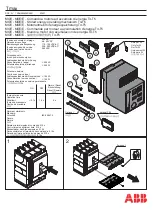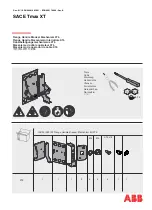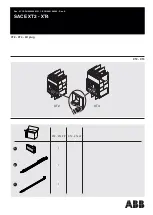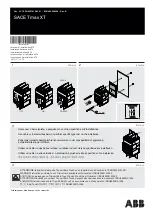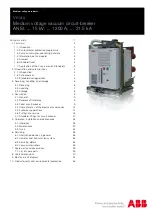
I.B. 3A74791H04
Page 26
Effective 7/97
SECTION 6: INSPECTION, MAINTENANCE
AND TROUBLESHOOTING
6-1 INTRODUCTION
• DO NOT WORK ON A CIRCUIT BREAKER IN THE
“CONNECTED” POSITION.
• DO NOT WORK ON A CIRCUIT BREAKER WITH
SECONDARY DISCONNECTS ENGAGED.
• DO NOT WORK ON A CIRCUIT BREAKER WITH
SPRINGS CHARGED OR CONTACTS CLOSED.
• DO NOT DEFEAT ANY SAFETY INTERLOCKS.
• DO NOT LEAVE MAINTENANCE TOOL IN THE
SOCKET AFTER CHARGING THE CLOSING
SPRINGS.
• DO NOT STAND LESS THAN FOUR METERS
AWAY FROM THE BREAKER WHEN TESTING
FOR VACUUM INTEGRITY.
FAILURE TO FOLLOW ANY OF THESE INSTRUC-
TIONS MAY CAUSE DEATH, SERIOUS BODILY
INJURY, OR PROPERTY DAMAGE. SEE SECTION 2-
SAFE PRACTICES FOR MORE INFORMATION.
6-2 FREQUENCY OF INSPECTION AND
MAINTENANCE
Periodic inspections and associated maintenance are
essential to the safe and reliable operation of W-VAC
Vacuum Circuit Breakers. The inspection frequency and
associated maintenance recommended are intended to
insure the best possible ongoing service. It is imperative
that an established schedule be followed. To establish
an exact schedule for a specific installation, use the fol-
lowing guidelines:
1. In a clean, non-corrosive environment, inspect and
maintain each circuit breaker annually or every 500
operations, which ever comes first.
2. For special conditions such as frequent circuit break-
er operation, contaminated environments, and high
temperature/humidity conditions, the inspection fre-
quency should be twice a year.
3. Inspect a circuit breaker every time it interrupts fault
current.
4. Follow the steps presented in Paragraph 6-3 entitled
“Inspection and Maintenance Procedures” for sched-
uled programs.
5. Create and maintain a dated permanent record of all
inspections, maintenance performed, actions taken,
observations made, and measurements taken. Not
only will this provide valuable historical information, it
can help to establish whether or not the present
schedule needs to be adjusted.
6. Perform ongoing visual inspections, when possible,
of all equipment on a regular basis. Be alert for an
accumulation of dirt in and around the circuit break-
ers, loose hardware or discolored insulation.
6-2.1 QUALIFIED PERSONNEL
For the purpose of operating switchgear equipment and
associated circuit breakers, only individuals thoroughly
trained in the operation of power circuit breakers and
associated equipment, and having knowledge of con-
nected loads may be considered to be qualified. Refer
to further definitions in any applicable codes.
For the purpose of inspecting and maintaining such
equipment, a qualified person must also be trained in
regard to the hazards inherent to working with electricity
and the proper way to perform such work. Such an indi-
vidual should be able to de-energize, clear and tag cir-
cuits in accordance with established safety practices. In
addition, these individuals should have access to and be
trained in the use of protective equipment, such as rub-
ber gloves and flash clothes.
All personnel should be familiar with and understand the
material presented in this instruction manual and other
related manuals.
6-2.2 HELPFUL TOOLS AND ACCESSORY ITEMS
To simplify the performance of inspection and mainte-
nance programs, the items described in Section 3-5 are
recommended.
6-2.3 GENERAL TORQUE GUIDELINES
Bolts and screws must be properly torqued. This is
especially true if parts and/or accessories are added or
replaced. Table 6.1 provides guidelines on torque lev-
els. The table is intended as a general guideline and
!
WARNING
Summary of Contents for 360 W-VAC 16
Page 2: ......






































